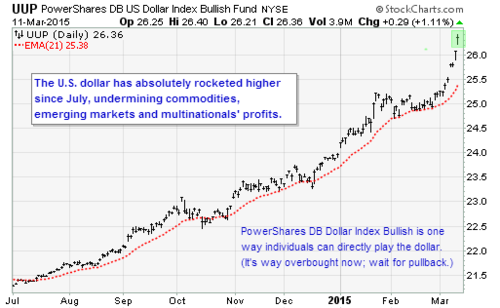Analyzing BlueChip Stocks (PG CL KMB)
Post on: 11 Апрель, 2015 No Comment

Some investors love nothing more than finding up-and-coming stocks that might make them a fortune overnight. Others are more interested in steady growth and the ability to sleep soundly at night. For those who fall into the more cautious group, blue-chip stocks hold special appeal. They probably won’t soar in value, but they boast a solid track record and tend to carry less risk than other equities.
So what are blue chips, exactly? Exact definitions vary, but the term generally applies to large, established corporations with a strong management team and consistent earnings growth. Think McDonald’s (NYSE:MCD ), Coca Cola (NYSE:KO ) and technology giant IBM (NYSE:IBM ), just to name a few.
Many of these firms have paid a dividend for decades, which is an enticing feature for investors seeking a more immediate return on their investment. And while these payouts aren’t always huge, they tend to be more predictable than increases in share price.
Here are some tips for evaluating a blue-chip stock and finding out whether it’s a good addition to your portfolio.
The Fundamentals
Blue chips by definition have a strong reputation, but that doesn’t mean they’re all created equal. Often, the first thing seasoned investors will do is look at the company’s fundamentals to figure out whether it’s on solid footing. Are corporate profits growing consistently? Is it valued fairly? Does the business rely heavily on debt to fuel its operations? These are some of the basic questions you’ll want to figure out before making a purchase.
A typical starting point is the organization’s earnings per share. or EPS. While present-day performance isn’t always a great measure of value – consider a promising young tech company, for example – blue chip businesses should ordinarily record a healthy profit. Of particular importance is whether the company is finding a way to increase profits over time and therefore boost shareholder value. Some financial news sources report the EPS growth rate over a set number of years, which helps uncover the firm’s overall trajectory. Such data is most useful when compared to other Fortune 500 businesses, particularly those in the same sector. This allows for a true apples-to-apples comparison.
Investors can use this earnings information to help determine whether the current per-share price represents a good deal. The most common way to do so is by finding the price-to-earnings ratio. which is readily available online. A lower P/E ratio is better. as it indicates an attractive share price in relation to corporate earnings.
While the P/E ratio can be helpful, there are dangers to over-emphasizing it, too. Here’s why: The earnings figure reported at the bottom of the income statement reflects cash transactions (e.g. labor and raw material costs) as well as accounting maneuvers like depreciation expenses. It also factors in one-time expenses. such as the sale of a major asset. These can obscure the broader picture of the enterprise.
The company’s actual cash flow numbers are harder to manipulate, making them an important tool for the discriminating investor. Businesses with more “free cash flow” – what’s left after paying operating and capital expenses – have more flexibility to market their products and invest in key projects. Fortunately, you don’t have to scour the cash flow statement to find what you need. Many websites publish the price-to-free cash flow ratio. which can be used along with the P/E ratio to get a handle on pricing. The higher the price-to-free cash flow ratio, the more expensive the company is considered.
Too Much Debt?
When it comes to blue-chip stocks, perhaps the biggest draw is the sense of security that they offer investors. Naturally, the last thing anyone wants to do is put their money into an established, big-name firm, only to learn that the company is drowning in debt. To minimize your risk, it’s always a good idea to look at the corporation’s overall capital structure. Doing so will help you determine whether the company is fueling its growth through earnings, or growing mainly through borrowing.
There are several useful formulas to help determine how much the company has borrowed relative to its size. One of the best is the long-term debt-to-equity ratio. Lower numbers represent less dependence on borrowing, indicating a smaller barrier to profit growth moving forward. Again, figures can vary from one industry to the next, so comparing similar businesses will bring the most accurate results.

Just as significant as the amount of borrowing is the company’s ability to actually service its debt. After all, how the debt is structured has a big impact on the company’s financials. The debt-service coverage ratio is a handy tool for figuring out how the business handles its payments. Simply take net operating income and divide by the total debt service (interest plus principal payments for the period). Anything under “1” indicates a negative cash flow, which is usually a warning sign of potential trouble ahead.
Sizing Up P&G
Let’s look at a well-known consumer products company, Procter & Gamble (NYSE:PG ), whose numerous brands include Tide, Oral-B and Bounty. As of October 22, 2013, the firm offers a more attractive P/E ratio than two of its main competitors, Colgate-Palmolive (NYSE:CL ) and Kimberly-Clark (NYSE:KMB ). At just over 20, it’s hard to call P&G a “steal.” Still, the figure is in line with many other blue chips.
P&G’s slightly higher price-to-free cash flow number is of some concern, although it’s certainly within the same ballpark as the other two firms. It’s also worth noting that the company is projected to offer a stronger dividend yield than Colgate-Palmolive, which means that more of P&G’s cash is being handed back to investors, which actually inflates the price-to-free cash ratio somewhat.
Another factor in Procter & Gamble’s favor is its low level of long-term debt. While too little borrowing can in some cases actually hinder a company, maintaining a modest debt load will help the company retain more of its operating income going forward.
Based on this information, the consensus among securities analysts leaned slightly toward the ‘buy’ side of the spectrum.
A look at Procter & Gamble and two of its competitors in the consumer staples category, Colgate-Palmolive and Kimberly-Clark, as of October 22, 2013.














